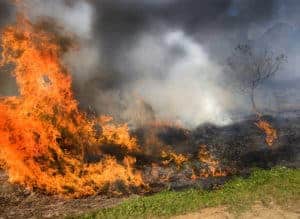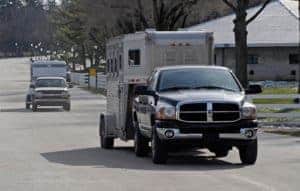Wildfires–Shelter in Place Planning
If the animals cannot be evacuated, the facility should have a shelter-in-place plan for the animals. Of course, shelter in place is not an option for most of us–our animals are boarded or live where there is not a possibility of survival. Animals should not remain in barns during wildfires, but should instead be housed in a pasture with all combustible vegetation removed. Water and forage (e.g., grass or hay) should be provided, and each animal should be properly identified. Avoid synthetic (e.g., nylon or plastic) halters or lead ropes that may melt and cause serious burns to the horse or the handler. Never use nylon sheets, fly masks, or other synthetic tack or equipment during a wildfire. Very few items of horse clothing are fire retardant.
If the flames are so close that they threaten your barn it is usually the wind blown cinders (partially burned materials such a leaves, paper, lightweight duff) that cause facilities to catch on fire before the flame front actually gets to the property. These can be blown in from hundreds of yards or even miles away. When choosing to live in an area subject to wild fires, facilities should be designed with wildfire and fire safety in mind: open ventilation, frost free hydrants, generators, and 33m (100 feet) minimum defensible space around each structure will allow fire crews to protect it from falling cinders and direct flames where there is not time to evacuate the animals to a safer place.
Consider FireWise plants to be used in landscaping. Your local extension service can provide a list of these species to you. There are no completely fireproof plants but some catch and spread fire more slowly so are much safer. Landscaping with “kindling” such as mulches made of combustibles, plants that easily catch on fire, and putting plants too close to buildings is foolish.
Tile roofs are relatively able to resist flame spread from these cinders, versus shake and composite roofs, which are more vulnerable. But few of us can afford tile roofs on our barns–and with a barn it is usually the ground floor where so many combustibles occur that the cinders are able to instigate flame (bedding, hay and straw storage are good examples) since so many barns are not able to be enclosed to prevent cinders blowing into the recesses of stalls and storage areas
Create a free account with TheHorse.com to view this content.
TheHorse.com is home to thousands of free articles about horse health care. In order to access some of our exclusive free content, you must be signed into TheHorse.com.
Start your free account today!
Already have an account?
and continue reading.
Written by:
REBECCA
Related Articles
Stay on top of the most recent Horse Health news with














